

APPENDIX B (PART 4)
HARMONY IN 20TH CENTURY POPULAR MUSIC
Modal and 'Blues-Modal' Harmony
This section is best read in conjunction with the links to the main book section of this website. Whilst there are many good books and websites that describe chord progressions in popular music, what is unique about this website is that it describes the underlying principles which govern chord progressions in tonal music. By understanding these, the reader will be able to understand the wide range of tonal (and some modal) chord progressions possible and understand how these relate to musical phrases.
Introduction
The modal system of scales existed before the modern western system of major and minor keys came into existence, sometime around 1600. Modal scales were a familiar part of medieval church music and are still familiar in folk melodies. Modal scales of various kinds are also used in music from non-western traditions.
Most (non-folk) popular music of the early 20th century uses tonal scales and harmony, often richly elaborated with chromatic harmonies and passing chords. During the 1950's some jazz musicians such as Miles Davis (in his Album Kind of Blue) re-introduced modal scales into Jazz. This was partly to facilitate a freer style of improvisation. In the 1960's some pop, rock guitar soloists started to use modal scales to improvise guitar solos.
First I'll give a quick summary of what I mean by modal scales and then discuss modal harmony. Please refer to the bibliography and web links if you would like more detailed information about modal scales.
In the major, minor tonal system, each major or minor scale contains the same intervals regardless of which note it starts on, however, in the modal system, there are a series of different scales that were originally created by starting on different 'white notes' as on the piano.
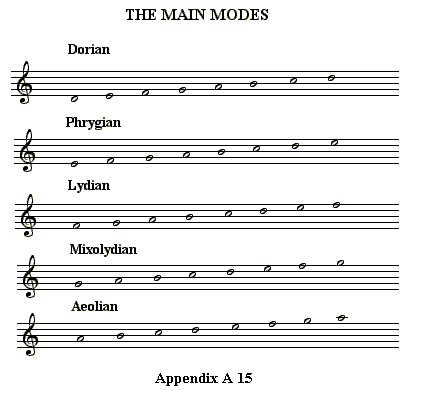
These are the five most used modes. Each is made up of a different sequence
of intervals, so that each has a different characteristic sound. In theory,
there is also a scale called the Ionian mode starting on C but
this is in effect the same as the major scale and therefore does not require
special attention here. There is a also a mode on B called the Locrian
mode but this is hardly ever used due to the lack of a perfect 5th
above the key note. (The fifth of the scale is F above B i.e. a diminished
5th).
The Dorian scale is common in folk melodies and is similar to the minor scale but the 6th degree of the scale is a major 6th above the final. (This is what the keynote or tonic is referred to in modal theory so I'll use the term final in future.) The Phrygian is less common and is also similar to the minor scale but the 2nd degree of the scale is flattened and the 7th degree is minor. The Lydian mode is similar to the major scale but has a sharpened 4th degree of the scale. The Mixolydian is similar to the major scale but has a minor 7th. The Aeolian is the same as the minor scale but retains a minor 7th whereas the the minor scales has the 6th and 7th degrees of the scale sharpened when a melodic line rises to the tonic.
The Dorian, Mixolydian and Aeolian are the most used. Each of these has the characteristic flattened 7th degree of the scale which creates the familiar flattened leading note sound which contrasts with the sharpened leading note of tonal music:
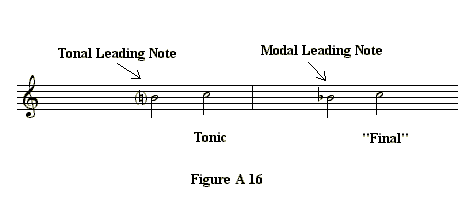
In the major and minor scales the leading note is a semitone below the tonic (except sometimes when a descending minor scale is used) but in the Dorian, Mixolydian and Aeolian modes the leading note is a whole tone below the final.
Nowadays, the modes can be transposed, just as the major and minor keys can. Key signatures are used in order to retain the correct sequence of intervals in each scale. For instance, to transpose the Dorian scale to start on A (rather than D) we use one sharp in the key signature. This retains the major 6th by the addition of F# above A.
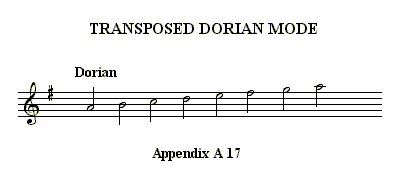
Folk Modal Harmony
Most folk melodies were originally sung without harmony or with just a single or double note drone as accompaniment. These songs are now usually harmonised by a kind of harmony which is appropriate to the scales used in folk music. In the following example, I've given a typical harmonisation of the sea shanty What Shall we do with the Drunken Sailor? Of course, there is no single way of harmonising this. This is just a typical simple harmonisation which fits the notes of the melody.
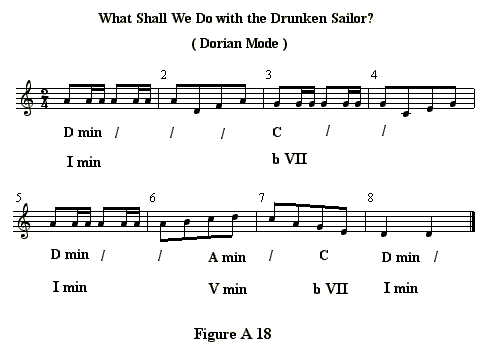
In the figure I've shown the chord symbols and also roman numerals. I've
shown the chord on the seventh degree of the scale as flat VII
as it is a normal convention to show the chord on the minor 7th in this
way. Although, strictly speaking, the root of the chord is neither on
a flattened note, nor in a key with any flats in the signature. It would
be just as correct to show VII but the normal convention just highlights
the fact that the 7th here is flat in relation to the normal leading note
of the major, minor key system.
This harmonisation contains static harmony and dynamic harmony patterns and a phrase structure similar to tonal music.
Static harmony is harmony which oscillates around one chord, normally the tonic but sometimes the dominant. i.e. there is a movement from the tonic chord to another chord followed by a return to the tonic. Where the harmony oscillates around the tonic it prolongs the tonic chord.
Dynamic harmony is a progression of chords without this oscillation.
However, there are important differences here, that make the harmonisation sound modal.
- The static harmony (bars 1- 6) is created using an auxiliary chord on the minor 7th degree of the scale. The static harmony pattern is as follows:
[ ] indicates an auxiliary chord, i.e. a chord which returns to the previous chord and consequently is used for creating static harmony.
Chord bVII is not normally used, in this way, in tonal music as the leading note is normally a semitone below the tonic. The result is a characteristically modal sounding static harmony pattern that is used in many modal melodies. It also produces an interesting and characteristic relationship whereby the main structural chord (D minor) is minor but the supporting non-structural chord (C major) is major.
For more on static harmony see book Chapter 2 and for more on functionality (i.e. structural and nonstructural chords) see Chapter 3.
- It is an important characteristic of tonal music that in dynamic harmony certain root progressions (rising fourth, falling 3rd and rising 2nd) are used in almost exclusive preference to the other possible root progressions. On this site, I've referred to these as the three strong root progressions and the other three possibilities as weak root progressions. (The use of these terms is to some extent arbitrary). However, in modal music there is no such preference. This is one reason that modal music sounds different to tonal music. In this example, D minor to A minor is a 'weak' falling 4th progression and the A minor to C major chord progression is the 'weak' rising 3rd progression. These weak progressions are normally avoided in tonal dynamic harmony.
See Chapter 2. for more on dynamic harmony and 'weak' and 'strong' root progressions.
- The modal bVII - I cadence substitutes for the usual tonal V - I cadence.
Consequently, this harmonisation follows the basic phrase structure used for tonal syntax (see section the three chord trick). However, all three elements of the syntax for this piece are modal. The syntax diagram can be drawn as follows:
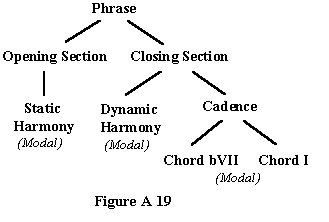
Modal harmonies became familiar in the 20th century popular music partly due to the revival of interest in folk music. Classical 20th century composers have also revived the use of modal scales and early music performers have recorded early music. Many folk influenced song writers have composed melodies that use modal scales and harmonies. Also, many pop / rock groups have used or composed modal melodies. For instance, in the 60's the Kinks songs Sunny Afternoon and Dead End Street start in the Aeolian mode, although both revert to tonality at the cadences. The Michael Jackson hit Thriller (Rod Temperton) is almost all in the Dorian mode. The mode is used here to create a 'gothic' effect. A similar churchy effect is produce by elements of the Aeolian and Dorian modes in The Beatles Eleanor Rigby. (However, look out for the long range linear progression: E - D - C# - C natural - B as this is also important in this song). The Red Hot Chili Pepper's hit Californication is totally Aeolian. It uses Im [VI] Im as static harmony and uses modal dynamic harmony. The cadences are plagal (IV - I).
See bibliography for Björnberg, A: On Aeolian harmony in contemporary popular music
'Blues-Modal' Harmony
Until the 1960's, modal harmony was used only for modal melodies. Blues related songs used the standard blues progression or some variation of it. However, during the 1960's some pop groups started to experiment with modal chord progressions as an alternative way of harmonising blues melodies. British Groups such as The Animals, The Rolling Stones and The Who were important in this development and blues-modal harmony became very important from that point on. It is common in Heavy Metal and other subsequent types of rock music. This created a new system of harmony that has influenced subsequent popular music.
The use of modal harmonies to harmonise the blues came about because of the similarity of the blues scale to modal scales. However, folk and folk influenced melodies generally use harmonies that keep within the mode and minor sounding modes are most common and these use minor chords (e.g. the Dorian and Aeolian modes). However, other popular music, both tonal and blues, lean heavily towards the use of major scales and major chords. Blues-modal harmony probably came about by experimentation with the possible uses of major chords on the guitar. This phenomenon thus probably derives from the characteristics of the guitar and the way it is used in popular music. This is also linked to the rise in the use of Power chords.
See web links for Wikipedia article on power chords.
In an earlier section, (The Three Chord Trick) we established that there are three major chords in the major key. If we examine the number of major chords available in the blues scale, as previously defined, we find the following: (See previous section and the bibliography and web links for more on the blues scale.)
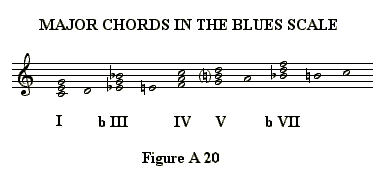
As well as the three primary chords: I, IV and V, as in the major scale, this provides two additional major chords on bIII and bVII. Note that the combination of these chords is not the same as in purely modal harmony. In modal harmony, the chords normally keep within the notes of the mode whereas this set of chords requires both the major and minor thirds and major and minor 7ths that are characteristic of the blues scale. For instance, the Aeolian mode on C would NOT have the C major chord, the F major chord or the G major chord and would consequently utilise minor chords as key harmonies.
Early blues influenced songs experimented with the use of bVII. Notable examples are the Animals song I'm Crying (1964) which uses I [ bVII ] I in the chorus but follows the standard 12 bar blues progression in the verse. The Who's My Generation (1965) uses I [ bVII ] I throughout as static harmony. Earlier power chord songs such as Link Wray's Rumble and The Kink's You Really Got Me used bVII as a kind of 'up beat' chord to the tonic.
When, bVII is juxtaposed with other major chords such as bIII and IV this creates a new kind of blues-modal dynamic harmony which is in effect an alternative way of harmonising blues songs.
The Rolling Stone's song Jumping Jack Flash is one of the earliest songs to fully integrate modal harmony into a blues melody. (If you know of earlier examples please let me know.) The song is a blues song because the melody involves 'blues notes and minor 7ths but the accompanying chords contain major 3rds in the tonic chord (B). However, the accompanying chord progression is NOT the standard 12 bar blues pattern. The accompaniment uses major chords and power chords as follows:
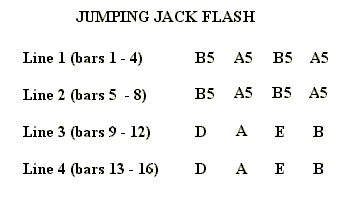
Note: B5 and A5 indicate power chords on B and A. The bass guitar sustains a B pedal beneath the lead riff which creates the A5 chord. The pedal note emphasises the static nature of the harmony.
In Roman numeral form this is:
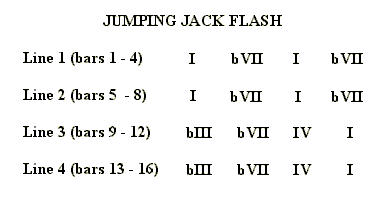
Rather than keeping to the familiar 3 chord blues progression, this song uses 4 of the 5 possible major chords in the blues scale. The only major chord not used is the dominant (chord V), the second most important chord in tonal harmony. The resulting harmony follows the basic syntactic structure familiar to tonal phrases but the result is significantly different from the normal tonal blues progression. Rather than being purely blues or purely modal in character this song has a distinctly hybrid character which I will refer to as blues-modal because it has a blues melody and a modal harmonic accompaniment.
The syntax diagram for this phrase structure can be represented as follows:
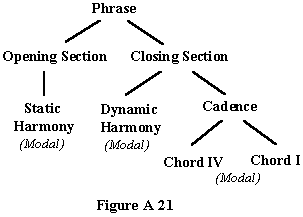
The first 8 bars (lines 1 and 2 of the melody) are all static
harmony. These bars are made up of a guitar riff that alternates between
a B power chord and an A power chord (no 3rd). This creates the modal:
I5 - [ bVII 5 ] - I5 static harmony. The bass guitar maintains a B pedal
note below the B and A power chords, emphasising the static nature of
the harmony.
For more on static harmony see book Chapter 2.
Bars 9 to 12 is dynamic harmony because there is a moving chord progression. However, the progressions used are all weak progressions (see above). B - D is a weak rising 3rd progression; D - A, A - E and E to B are all falling 4th progressions. These are the complete opposite of the falling 3rd and rising fourth progressions normally used in tonal dynamic harmony. Bars 13 to 16 repeat the same chord progressions and complete the dynamic harmony. The final IV to I substitutes a 'plagal' (IV - I) cadence for the normal V - (IV) - I blues cadence. This plagal cadence has a characteristically modal sound, especially where there is no preceding chord V.
Other examples of songs with Blues-modal elements are as follows: Several of The Who songs are either blues-modal or contain blues-modal elements. As already mentioned My Generation uses I [ bVII ] I throughout. The Magic Bus uses I [ Vm ] I as static harmony. I Can See for Miles uses bIII in modal dynamic harmony as does Acid Queen. Led Zeppelin's The Rover uses bVII and bIII in modal dynamic harmony and in In My Time of Dying use bIII in modal dynamic harmony. The Stones song (Womack and Womack) It's All Over Now has a blues-modal introduction which uses bVII. Jonathan Larson in the theme tune to Rent uses tonal, blues and blues-modal harmonies at different points in the composition.
For more on the syntax of the blues progression and the blues cadence, see the previous section.
See Chapter 2 for more on dynamic harmony
See glossary - cadence also Chapter 1 and Chapter 5.
The kind of modal harmony discussed here, in both folk melody harmonisation and in blues-modal harmony is not a return to the way modes were harmonised in the church music of the renaissance or the way folk music was originally accompanied but is a new way of combining modal scales with components of the tonal phrase syntax to create new harmonic systems.
Harmony in Popular Music Index
Ver 2.4.
